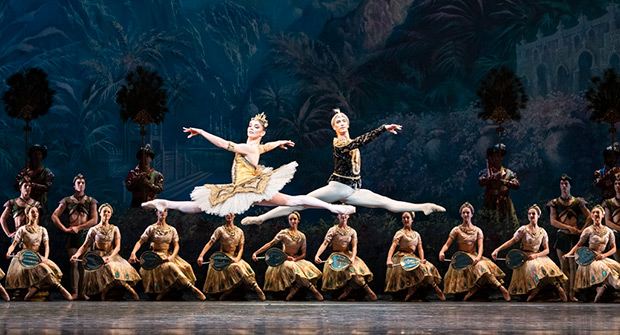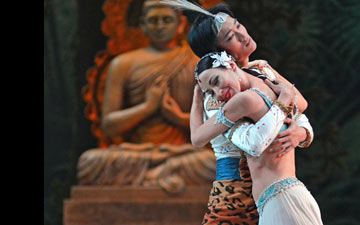
© Foteini Christofilopoulou, courtesy the Royal Opera House. (Click image for larger version)
Royal Ballet
La Bayadère
London, Royal Opera House
1 November 2018
Gallery of pictures by Foteini Christofilopoulou
www.roh.org.uk
Natalia Makarova was brought on stage by Vadim Muntagirov to take a curtain call after the opening night revival of her 1989 production of La Bayadère. Even in high heels, she appeared diminutive beside him, the Royal Ballet’s tallest Solor. She received an enthusiastic reception from an audience who then gasped in commiseration as the conductor, Boris Gruzin, tumbled over a floral tribute. His was the only slip in an otherwise triumphant performance at the start of the ballet’s run of 12 performances.
Makarova’s production is a pared down version of the 1877 ballet, leaving out some of the ‘ethnic’ dances in the Mariinsky productions and curtailing Nikiya’s despairing solo before her death. The last act with the destruction of the temple is Makarova’s imagined recreation of an ending that other accounts omit – including Nureyev’s last production for the Paris Opera Ballet.

© Foteini Christofilopoulou, courtesy the Royal Opera House. (Click image for larger version)
In the past, the Royal Ballet’s version, last performed five years ago, has sometimes seemed insubstantial. No so this time, with a luxury cast in full dramatic mode: Muntagirov, Marianela Nuñez as Nikiya, Natalia Osipova as Gamzatti and Gary Avis as the High Brahmin. Because I had a bad seat in the stalls, I couldn’t see Nikiya’s entrance in Act I, so relied on Avis’s reactions. He went through a full gamut of emotions – struck to the heart by her beauty, ashamed of his lust, humiliation at her rejection of him, intense jealousy of her love for Solor, hatred of him.
What I could see of the pas de deux between Solor and Nikiya expressed their tenderness, with lifts serving as loving embraces rather than declarations of passion. Muntagirov dances Solor with such sincerity that his subjugation to Gamzatti’s rich and powerful family becomes more distressing than usual.

© Foteini Christofilopoulou, courtesy the Royal Opera House. (Click image for larger version)
He hasn’t a chance against Osipova’s sense of entitlement as the Rajah’s daughter. Thomas Whitehead as the vainglorious Rajah is wonderfully pompous, towered over by Solor and his best friend, Nicol Edmunds. I watched the introductory chess match between Osipova’s Gamzatti and her intended fiançé (couldn’t see the Djampeh dancers). She had taken his king before he could mount a defence. Like Mary Vetsera in Mayerling, she had evidently been obsessed by his portrait before meeting him – hence her fury when she eavesdrops on the Brahmin’s revelation of Solor’s love for Nikiya.
Osipova treats her rival with vicious contempt, trying to buy off Nikiya before deciding she has to die for daring to challenge her. There is a touch of Odile in Osipova’s exultant dancing in the betrothal scene, confident that she has got her man. Muntagirov obliges her by matching her every step, though his heart is very evidently elsewhere: he manages to appear elegantly pained as he partners her courteously and executes his own virtuoso feats.

© Foteini Christofilopoulou, courtesy the Royal Opera House. (Click image for larger version)
Nuñez’s Nikiya, heartbroken, performs ever more extravagant backbends in her reproachful solo, disappearing below my compromised sightline. I did catch her vehement accusation of Gamzatti’s guilt and Osipova’s ever-so-innocent denial. Muntagirov returned to grieve over Nikiya’s death, to my surprise, instead of continuing to walk away with his betrothed and her father. This Solor is allowed to remain genuinely in love with Nikiya instead of two-timing her with only faint regret.
Aafter the first interval, thanks to a better seat, I was able to see The Kingdom of the Shades and the last act. The corps of bayadères descended from the Himalayas immaculately, led by Roman Pajdak. If only there were more than 24 of them to keep going into infinity! The Russians field 32, as does the Paris Opera, and Petipa once required 48. My only quibble is that they pause the arabesque leg before raising it, which Nureyev wouldn’t allow when he staged The Kingdom of the Shades for the Royal Ballet back in the 1960s.

© Foteini Christofilopoulou, courtesy the Royal Opera House. (Click image for larger version)
Nuñez observes the Mariinsky requirement to keep her arabesque line at 90 degrees when she announces her arrival to kneeling Solor. Nikiya’s Shade is a pure classical ballerina without distorted extensions or whizzing pirouettes: she is showing remorseful Solor the spiritual grace of a heavenly realm. Nuñez trusts Muntagirov to be exactly where she wants him so that her phrasing of Petipa’s choreography flows without interruption, as Makarova’s always did. They enjoy a technique that seems effortless, unshowy, inevitable.
Muntagirov conveys Solor’s regret through every long line of his body, aching to unite with his vision of Nikiya. He’s left footed, so the spectacular anti-clockwise manège of double assemblées holds few terrors for him. He dances Solor as an aristocrat, not a warrior (in spite of having slain an implausible tiger before his proud entrance in Act I). He draws the audience to him rather than projecting to the back of the auditorium.

© Foteini Christofilopoulou, courtesy the Royal Opera House. (Click image for larger version)
The three soloist Shades need to agree on tempi with the conductor before the live relay in cinemas on 13 November. Yuhui Choe is prettily speedy in the first variation, Yasmine Naghdi laboured in the slow one and Akane Takada could hold on longer to her third cabriole. None the less, The Kingdom of the Shades in this performance was proof that the Royal Ballet can do Makarova’s production proud, fired up by a run of fascinating non-classical Mayerlings. All they need to do now is sort out the collapse of the Buddha in Act II, avoid the shadow on the backdrop of the apotheosis, and show the world in the cinema relay how wonderful they can be.

















You must be logged in to post a comment.